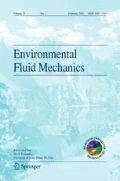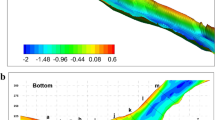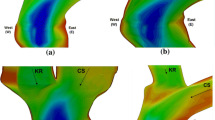Abstract
Stratification effects induced by density differences between the incoming flows are investigated at a medium-size stream confluence with a highly discordant bed. The relatively large temperature difference ΔT = 4.7 °C between the main, high-discharge tributary and the low-discharge tributary together with the relatively small velocity of the flow in the main channel translate in a very high Richardson number, Ri = 1.89, which suggests that stratification effects have an important effect on flow hydrodynamics and thermal mixing. Simulation results confirm this and show that for the case when the velocity of the low-discharge, lower-temperature tributary is much smaller than that of the high-discharge tributary, the denser fluid from the low-discharge tributary plunges rapidly toward the bottom and the confluence apex. It then moves as a near-bed current of denser fluid across the main-tributary side of the main channel until the opposing bank where it reaches the free surface. It then continues to move parallel to the bank line. Meanwhile, the less-dense fluid from the main tributary moves over the near-bed current of denser fluid into the central part of the main channel. This induces a two-layer structure of the flow inside the upstream part of the confluence, which explains the very different mean flow patterns near the bed and near the free surface. Flow hydrodynamics and mixing in the Ri = 1.89 simulation are found to be very different when compared to those observed in the no-density-effects (Ri = 0) case where there is no coupling between the temperature and the momentum equations via the Boussinesq approximation. In this case, the fluid from the low-discharge tributary remains on the corresponding side of the main channel. Away from the confluence apex, the volume of mixed fluid is several times larger in the Ri = 1.89 simulation, which demonstrates that under certain conditions two streams of unequal densities can mix much faster compared to the case when the two streams have the same density. The large-scale flow patterns, eddy dynamics and volume of mixed fluid in the Ri = 1.89 simulation were also found to present major differences with a case where the main, high-discharge tributary contained the lower-temperature (denser) fluid.














Similar content being viewed by others
References
Arbat-Bofill M, Palau A, Sanchez-Junni M, Castellet EB, Ninerola D, Dolz J (2014) Hydrodynamics of Ribarroja Reservoir (Ebro River, Spain): water temperature, water velocities and water age. In: Schleiss A (ed) Proceedings of the RiverFlow 2014 international conference on fluvial hydraulics, Lausanne, Switzerland. Taylor and Francis, London
Arthus-Bertrand Y, Burleigh R (2005) Earth from above. Publisher Harry Abrams, New York. ISBN 081095947X
Beluco A, de Souza PK (2014) Energy at the junction of the Rivers Negro and Solimoes, contributors of the Amazon River, in the Brazilian Amazon. Int Sch Res Notices 2014, 794583. https://doi.org/10.1155/2014/794583
Best J, Parsons D, Kellman P, Amsler M, Szupiany R, Kostaschuck R, Lane S, Hardy R, Orfeo O (2007) On the influence of density contrasts between mixing flows at channel confluences: the Río Bermejo and Río Paraguay, Argentina. Workshop on Morphodynamic Processes in Large Lowland Rivers, Santa Fe, Argentina, November 2007
Best JL, Rhoads B (2008) Sediment transport, bed morphology and the sedimentology of river channel confluences. In: Rice S, Roy A, Rhoads B (eds) River confluences, tributaries and the fluvial network. Wiley, Hoboken, pp 45–72. https://doi.org/10.1002/9780470760383.ch4
Boyer C, Roy AG, Nest JL (2006) Dynamics of a river channel confluence with discordant beds: flow turbulence, bed load sediment transport, and bed morphology. J Geophys Res 111:F04007
Bouchez J, Lajeunesse E, Gaillardet J, France Lanord C, Dutra Maia P, Maurice L (2010) Turbulent mixing in the Amazon River: the isotopic memory of confluences, Earth Planet. Sci Lett 290:37–43
Bradbrook KF, Lane SN, Richards KS (1998) Investigation of controls on secondary circulation in a simple confluence geometry using a three-dimensional model. Hydrol Process 12:1371–1396
Chang KS, Constantinescu G, Park SO (2007) Assessment of predictive capabilities of Detached Eddy Simulation to simulate flow and mass transport past open cavities. ASME J Fluids Eng 129(11):1372–1383
Cheng Z, Constantinescu G (2014) Spatial development of constant-depth shallow mixing layer in a long channel. In: International conference on fluvial hydraulics, River Flow 2014, Lausanne, Switzerland
Cheng Z, Constantinescu G (2018) Stratification effects on flow hydrodynamics and mixing at a confluence with a highly discordant bed and a relatively low velocity ratio. Water Resour Res 54(7):4537–4562. https://doi.org/10.1029/2017WR022292
Cheng Z, Koken M, Constantinescu G (2018) Approximate methodology to account for effects of coherent structures on sediment entrainment in RANS simulations with a movable bed and applications to pier scour. Adv Water Resour. https://doi.org/10.1016/j.advwatres.2017.05.019
Constantinescu G (2014) LE of shallow mixing interfaces: a review. Environ Fluid Mech 14:971–996. https://doi.org/10.1007/s10652-013-9303-6
Constantinescu G, Chapelet MC, Squires KD (2003) Turbulence modeling applied to flow over a sphere. AIAA J 41(9):1733–1743
Constantinescu G, Miyawaki S, Rhoads B, Sukhodolov A, Kirkil G (2011) Structure of turbulent flow at a river confluence with a momentum and velocity ratios close to 1: insight from an eddy-resolving numerical simulation. Water Resour Res 47:W05507. https://doi.org/10.1029/2010WR010018
Constantinescu G, Miyawaki S, Rhoads B, Sukhodolov A (2012) Numerical analysis of the effect of momentum ratio on the dynamics and sediment entrainment capacity of coherent flow structures at a stream confluence. J Geophys Res Earth Surface 117:F04028. https://doi.org/10.1029/2012JF002452
Constantinescu G, Miyawaki S, Rhoads B, Sukhodolov A (2014) Numerical evaluation of the effects of planform geometry and inflow conditions on flow, turbulence structure, and bed shear velocity at a stream confluence with a concordant bed. J Geophys Res Earth Surface 119:2079–2097. https://doi.org/10.1002/2014JF003244
Constantinescu G, Miyawaki S, Rhoads B, Sukhodolov A (2016) Influence of planform geometry and momentum ratio on thermal mixing at a stream confluence with a concordant bed. Environ Fluid Mech 16(4):845–873. https://doi.org/10.1007/s10652-016-9457-0
De Serres B, Roy AG, Best JL (1999) Three-dimensional structure of flow at a confluence of river channels with discordant beds. Geomorphology 26:313–335
Gaudet JM, Roy AG (1995) Effect of bed morphology on flow mixing length at river confluences. Nature 373:138–139
Guillén-Ludeña S, Franca MJ, Cardoso AH, Schleiss AJ (2015) Hydro-morphodynamic evolution in a 90 movable bed discordant confluence with low discharge ratio. Earth Surf Proc Land 40(14):1927–1938. https://doi.org/10.1002/esp.3770
Guillén-Ludeña S, Franca MJ, Cardoso AH, Schleiss AJ (2016) Evolution of the hydromorphodynamics of mountain river confluences for varying discharge ratios and junction angles. Geomorphology 255:1–15. https://doi.org/10.1016/j.geomorph.2015.12.006
Guillén-Ludeña S, Cheng Z, Constantinescu G, Franca MJ (2017) Hydrodynamics of mountain river confluences and its relationship to sediment transport. J Geophys Res Earth Surface 122:901–924. https://doi.org/10.1002/2016JF0044122
Konsoer K, Rhoads B (2014) Spatial–temporal structure of mixing interface turbulence at two large river confluences. Environ Fluid Mech 14(5):1043–1070
Lane SN, Parsons DR, Nest JL, Orfeo O, Kostaschuk RA, Hardy RJ (2008) Causes of rapid mixing at a junction of two large rivers: Rıo Parana and Rıo Paraguay, Argentina. J Geophys Res 113:F02019. https://doi.org/10.1029/2006JF000745
Laraque A, Guyot JL, Filizola N (2009) Mixing processes in the Amazon River at the confluences of the Negro and Solimnoes rivers, Encontro das Aquas, Manaus, Brasil. Hydrol Process 23:3131–3140
Leite Ribeiro M, Blanckaert K, Roy AG, Schleiss AJ (2012) Flow and sediment dynamics in channel confluences. J Geophys Res 117:F01035. https://doi.org/10.1029/2011JF002171
Leite Ribeiro M, Blanckaert K, Roy AG, Schleiss AJ (2012) Hydromorphological implications of local tributary widening for river rehabilitation. Water Resour Res 48(10):10528
Leite Ribeiro M, Blanckaert K, Schleiss AJ (2014) Local tributary widening for river rehabilitation. Ecohydrology 9(2):204. https://doi.org/10.1002/eco.1588
Lewis QW, Rhoads B (2015) Rates and patterns of thermal mixing at a small stream confluence under variable incoming flow conditions. Hydrol Process 29:4442–4456. https://doi.org/10.1002/hyp10496
Lyubimova T, Lepikhin A, Konovalov V, Parshakova Y, Tiunov A (2014) Formation of the density currents in the zone of confluence of two rivers. J Hydrol 508:328–342
Martí-Cardona B, Arbat-Bofill M, Prats J, Pipia L (2016) Thermal remote sensing for reservoir modelling and management. Living planet symposium, May 2016, Prague, Czech Republic. SP-740
Orr TS, Domaradzki JA, Spedding GR, Constantinescu G (2015) Description of the near wake of a sphere in a steady horizontal motion through a linearly stratified fluid at Re = 10000. Phys Fluids 27:035113. https://doi.org/10.1063/1.4915139
Paola C (1997) When streams collide. Nature 387:232–233
Prats J, Armengol J, Marcé R, Sánchez-Juny M, Dolz J (2010) Dams and reservoirs in the lower Ebro River and its effects on the river thermal cycle. Hdb Envion Chem 13:77–95
Ramón CL, Hoyer AB, Armengol J, Dolz J (2013) Mixing and circulation at the confluence of two rivers entering a meandering reservoir. Water Resour Res 49:1429–1445
Ramón CL, Prats J, Rueda F (2016) The influence of flow inertia, buoyancy, wind, and flow unsteadiness on mixing at the asymmetrical confluence of two large rivers. J Hydrol 539:11–26
Ramón CL, Armengol J, Dolz J, Prats J, Rueda F (2014) Mixing dynamics at the confluence of two large rivers undergoing weak density variations. J Geophys Res-Oceans 119(4):2386–2402
Rice SP, Kiffney P, Greene C, Pess GR (2008) The ecological importance of tributaries and confluences. In: Rice SP, Roy AG, Rhoads BL (eds) River confluences, tributaries and the fluvial network. Wiley, Chichester, pp 209–242
Riley JD, Rhoads B, Parsons DR, Johnson KK (2015) Influence of junction angle on three-dimensional flow structure and bed morphology at confluent meander bends during different hydrological conditions. Earth Surf Proc Land 40:252–271
Rodi W, Constantinescu G, Stoesser T (2013) Large eddy simulation in hydraulics IAHR monograph. CRC Press, Boca Raton. ISBN-10-1138000247
Roy AG, Bergeron N (1990) Flow and particle paths in a natural river confluence with coarse bed material. Geomorphology 3:99–112
Roy AG, Roy R (1988) Changes in channel size at river confluences with coarse bed material. Earth Surf Proc Land 13:77–84
Roy AB, Roy R, Bergeron N (1988) Hydraulic geometry and changes in flow velocity at a river confluence with coarse bed material. Earth Surf Proc Land 13:583–598
Sukhodolov A, Krick J, Sukhodolova T, Cheng Z, Rhoads B, Constantinescu G (2017) Turbulent flow structure at a discordant river confluence: asymmetric jet dynamics with implications for channel morphology. J. Geophys Res Earth Surface 122:1278–1293. https://doi.org/10.1002/2016JF004126
Tang H, Zhang H, Yuan S (2017) Hydrodynamics and contaminant transport on a degraded bed at a 90-degree channel confluence. Environ Fluid Mech 18(2):443–463
Le Trung B, Khosronejad A, Sotiropoulod F, Bartelt N, Woldeamlak S, Dewall P (2019) Large-eddy simulation of the Mississippi River under base-flow condition: hydrodynamics of a natural diffluence-confluence region. J Hydraul Res 57(6):836–851
Yalin MS, da Silva AMF (2001) Fluvial processes. Kluwer (IAHR) Monograph, Delft. ISBN 90-805649-2-3
Yuan S, Tang H, Qiu X, Xia Y (2018) Water flow and sediment transport at open channel confluences: an experimental study. J Hydraul Res 56(3):335–350
Zeng J, Constantinescu G, Weber L (2010) 3D calculations of equilibrium conditions in loose-bed open channels with significant suspended sediment load. J Hydraul Eng 136(9):557–571. https://doi.org/10.1061/(ASCE)HY.1943-7900.0000213
Zilitinkevich SS, Elperin T, Kleeorin N, Rogachevskii I (2007) Energy- and flux-budget (EFB) turbulence closure model for stably stratified flows. Bound Layer Meteorol 125:167–191
Acknowledgements
The authors would like to thank Dr. J. Prats-Rodriguez, Prof. E. Blade and Prof. J. Dolz for providing the bathymetry data and flow conditions needed to perform the simulations, as well as for insightful discussions. The authors would like to thank Dr. Anand Padmanabhan and the National Center for Supercomputing Applications (NCSA) at the University of Illinois at Urbana-Champaign (UIUC) for providing the computational resources needed to perform the simulations. This work was supported by the BCS Geography and Spatial Sciences Program of the US National Science Foundation under GRANT No. 1359836. Any opinions, findings, and conclusions or recommendations expressed in this material are those of the authors and do not necessarily reflect the views of the U.S. National Science Foundation.
Author information
Authors and Affiliations
Corresponding author
Additional information
Publisher's Note
Springer Nature remains neutral with regard to jurisdictional claims in published maps and institutional affiliations.
Rights and permissions
About this article
Cite this article
Cheng, Z., Constantinescu, G. Stratification effects on hydrodynamics and mixing at a river confluence with discordant bed. Environ Fluid Mech 20, 843–872 (2020). https://doi.org/10.1007/s10652-019-09725-6
Received:
Accepted:
Published:
Issue Date:
DOI: https://doi.org/10.1007/s10652-019-09725-6




